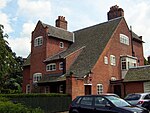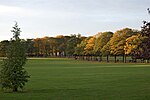Clarendon Park Congregational Church

The Clarendon Park Congregational Church is a Congregational church in Leicester, Leicestershire, UK. It is located on London Road in the Stoneygate district near Clarendon Park.Among the many places of worship in Leicester are Congregational churches. The first Congregational church in Leicester was founded in 1801. Numerous others were built in the 19th century. The Clarendon Park Congregational Church was designed by James Tait (1834-1915) and built in 1886. It is built of granite rubble with ashlar dressings and a roof of red tiles. It was designated a Grade II listed building (13613930) in 1975.The church is part of the Congregational Federation.
Excerpt from the Wikipedia article Clarendon Park Congregational Church (License: CC BY-SA 3.0, Authors, Images).Clarendon Park Congregational Church
Springfield Road, Leicester Clarendon Park
Geographical coordinates (GPS) Address External links Nearby Places Show on map
Geographical coordinates (GPS)
| Latitude | Longitude |
|---|---|
| N 52.618222222222 ° | E -1.1101944444444 ° |
Address
Clarendon Park Congregational Church
Springfield Road
LE2 3BB Leicester, Clarendon Park
England, United Kingdom
Open on Google Maps








